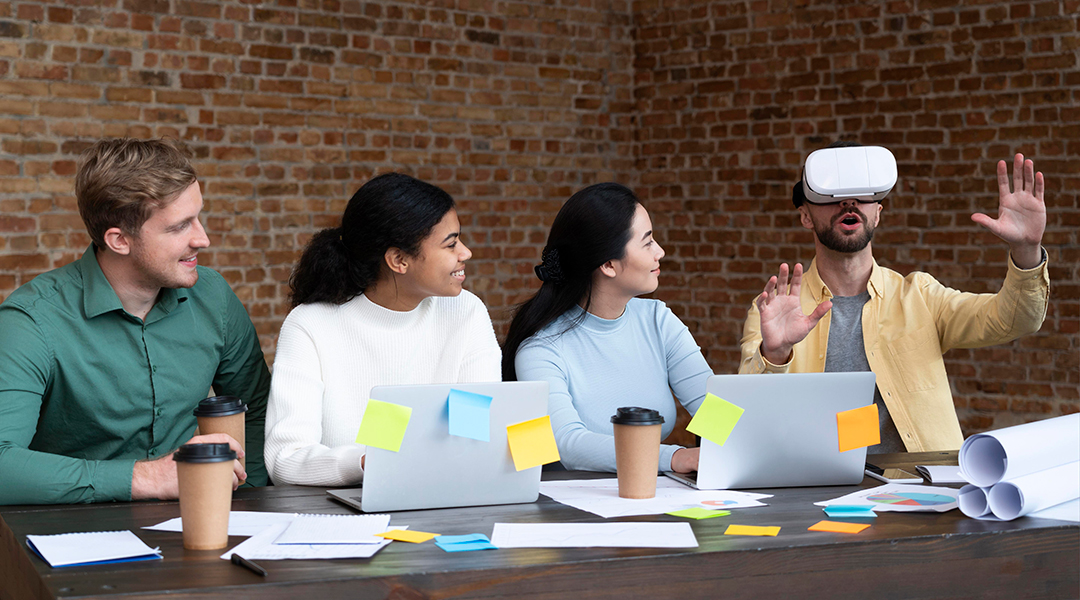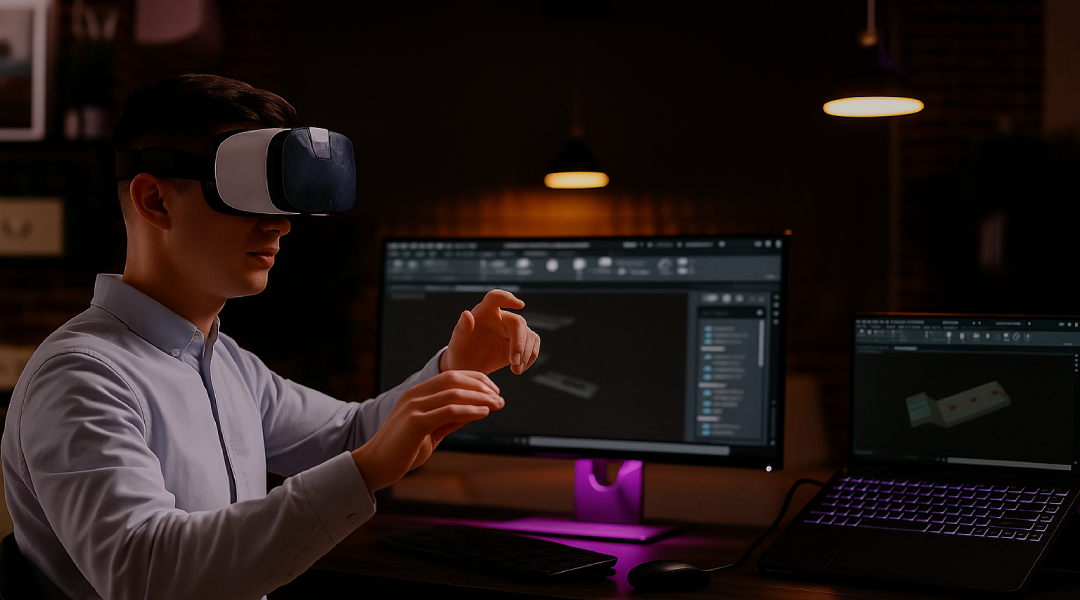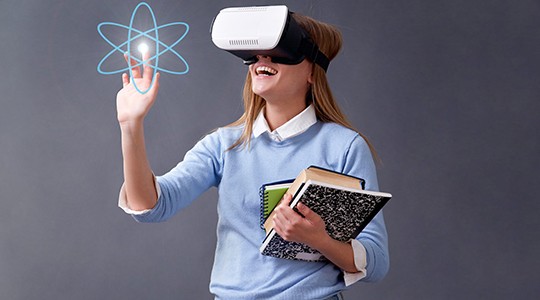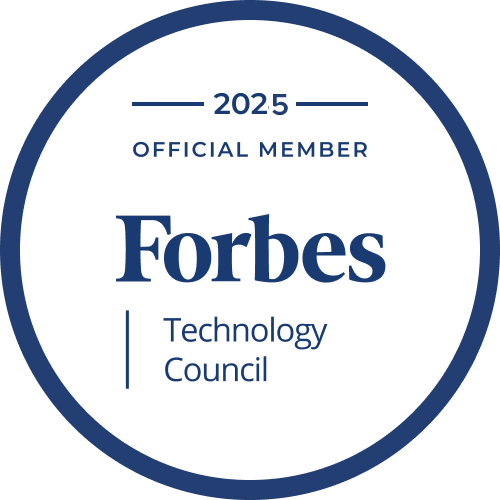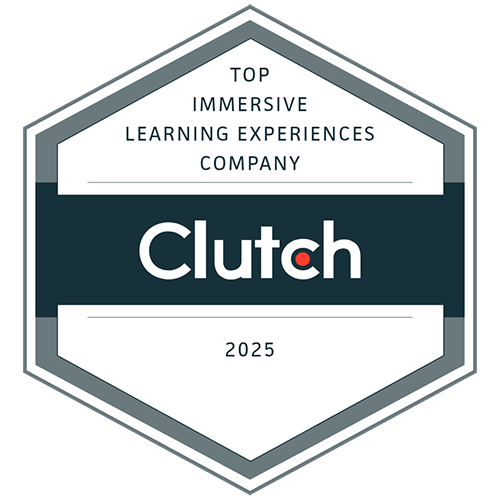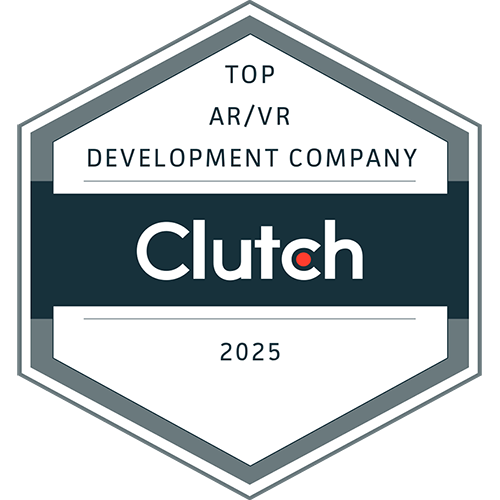Virtual reality in education is no longer science fiction. Schools, universities, and training centers already use it to support practical learning. Students can perform tasks in a fully simulated space instead of just watching a video or reading a manual. Education in virtual reality makes lessons more interactive and hands-on. For example, medical students can practice surgery, and engineering students can build machines without real-world risk.
Virtual training helps learners focus better and stay engaged longer. It can also shorten the time needed to understand complex concepts. Because virtual environments can be repeated and adjusted, students can practice until they master a skill.
Virtual reality applications in education are expanding fast. Institutions use them for soft skills, technical training, and even special education. This shift is not just about new tools. It’s about changing how people learn.
The cost of virtual reality in education is still a concern, but more affordable hardware is making it easier to adopt. Before using this technology, it’s important to understand its features, use cases, and possible limits.
The Rise of Virtual Reality in Education

More schools and training centers choose virtual reality to improve how students learn. You can simulate real-life tasks and environments instead of only using books or lectures. Almost every virtual reality training company often works directly with educators to build custom programs.
The technology has become easier to use and more affordable. That’s why even small institutions now consider it a realistic option. Instead of replacing teachers, VR supports them by offering more active learning experiences. As more industries require hands-on skills, education is adapting to meet that demand quickly.
Why Now? Technological and Social Drivers Behind the Surge
A mix of better hardware, new expectations in education, and shifting industry needs explains why VR is gaining speed in classrooms and training centers. Institutions now have more reasons — and better tools — to use virtual education in real settings.
Technological drivers:
- Lower hardware costs. VR headsets and supporting devices are now affordable, even for small institutions or individual educators.
- Stronger processors. Devices can run smoother, more detailed simulations without external computers.
- Standalone devices. You no longer need a PC or wires; portable headsets like Meta Quest make setup quick and simple.
- Wider content access. Educational platforms offer libraries with pre-built VR lessons for various subjects.
- Better network support. Fast and stable internet enables smoother multiplayer VR sessions and cloud-based updates.
Social and educational drivers:
- Student engagement problems. Traditional methods like lectures or slides don’t hold attention for long. VR makes lessons interactive.
- Post-pandemic learning gaps. Many schools learned that basic online tools don’t support hands-on learning. VR fills that gap.
- Demand for real skills. Employers want people with practical experience. VR helps students build those skills through safe, repeatable practice.
- Teacher support tools. Instructors use VR to track progress, give instant feedback, and adapt content for each learner.
- Familiarity with digital tools. Students already use technology daily. VR feels natural and easy to adopt.
Implementing VR in education no longer requires complex infrastructure. With the right tools and planning, schools and training providers can launch effective programs that support real-world learning needs.
Core Features of Education in Virtual Reality
Virtual education tools often include 3D environments, motion tracking, and real-time feedback. Students can interact with virtual objects, follow custom learning paths, and complete practice sessions designed around real tasks. Most tools support voice input, hand gestures, and movement inside the space, so you don’t just watch content — you experience it. Current virtual reality trends also include AI-driven personalization, multiplayer scenarios, and easier classroom integration. Instead of offering general content, modern platforms focus on tailored, skill-based learning.
Immersive 3D Environments and Real-Time Interaction
One key advantage of virtual reality in education is how it creates lifelike environments that students can actively explore. Instead of reading about a process, learners can step inside a simulation and practice the task directly. For example, a biology student can walk through a virtual human body, while a welding student can complete safety drills without real danger. Interactions in these spaces feel natural. Users reach out, move, or speak as they would in real life.
Real-time interaction improves both engagement and comprehension. Learners can work with objects, take part in simulations, or collaborate with peers inside the same virtual classroom. Instructors can track performance live, give direct feedback, or adjust scenarios instantly. That allows you to focus on weak spots or repeat tasks without interrupting others.
VR also supports sensory learning. Audio cues, motion feedback, and visual prompts help students stay focused and remember more. Timing is another factor. Students don’t need to wait for lab space or specific dates. Simulations are available anytime, making training faster and more flexible. Instead of reading about how something works, you can interact with it, which leads to more substantial learning outcomes.
Personalized Learning Paths and Adaptive Scenarios
Not all students learn the same way or at the same pace. Virtual education makes it easier to adjust content and tasks to match individual needs. Adaptive learning systems in VR track user behavior and performance in real time, then adjust the content to fill knowledge gaps or offer more challenges where needed.
- Custom starting points. Students can begin training at the skill level that matches their current knowledge.
- Real-time difficulty scaling. Tasks can get harder or easier depending on how well the learner performs.
- Skill-based branching. Learners who succeed in one type of task may be guided toward more advanced or specialized modules.
- Timed progress checks. Systems can pause and test understanding before moving to the next section, making sure nothing is skipped.
- Repetition control. Students can repeat tasks as many times as needed without slowing down a class or wasting instructor time.
- Error tracking and feedback. Mistakes are logged, and direct guidance is given to prevent repeating them in the future.
- Flexible goal setting. The VR system allows learners to set their own targets and timelines, which helps build self-discipline.
By using adaptive scenarios, instructors avoid the one-size-fits-all model. That not only improves performance but also keeps students more engaged since the content always matches their pace and goals. VR makes this level of personalization easier to manage at scale.
Real-World Examples of Virtual Reality Applications in Education
Schools and universities are starting to rely on virtual reality training solutions to support more practical learning. Mindflight7 in Australia, for example, brings immersive environments into classrooms, helping students engage more deeply with the material. Schools that adopt this technology report higher levels of focus and information retention during lessons.
Medical Training Simulations and Virtual Anatomy Labs
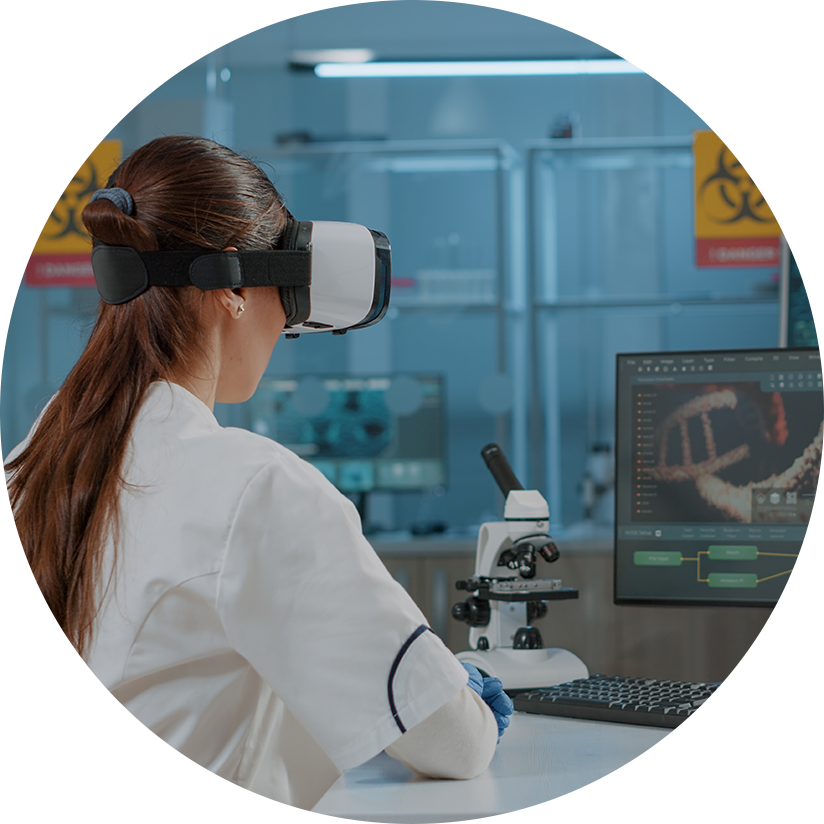
Medical students today often use virtual reality in medical training to practice clinical procedures and improve decision-making. Columbia University’s Clinical Innovation Lab built VR simulations where users perform real-world scenarios like emergency interventions or diagnostics. Instead of learning only through text or lectures, students enter high-stress medical situations where they must act quickly and precisely. Mistakes made in this controlled digital space help students improve without harming anyone.
Nursing education also includes VR, especially when addressing bias and equity in patient care. UbiSim designed scenarios that train nurses to interact with diverse patients in emotionally sensitive situations. Practicing in virtual environments gives learners the chance to repeat scenarios until they respond effectively, which helps build confidence and competence before treating actual patients.
By offering visual, auditory, and movement-based feedback, VR helps future healthcare providers gain practical skills earlier in their training. Repetition, immediate evaluation, and context-rich tasks make this method especially effective for high-stakes professions.
Engineering and Technical Education in VR
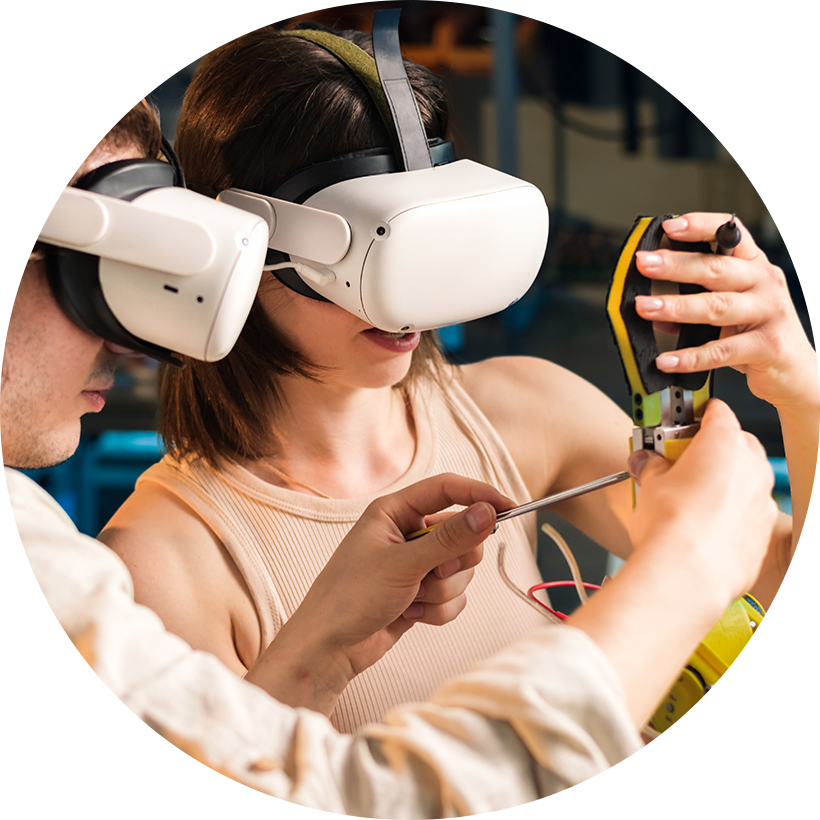
Engineering students now use VR to understand systems and designs through full-scale 3D environments. At the University of Nottingham, learners enter virtual classrooms where they manipulate engineering models and observe how changes affect function or structure. This hands-on interaction improves understanding, especially for mechanical or architectural concepts that are difficult to grasp from static diagrams.
Another strong example comes from the University of Michigan. In their Augmented Tectonics course, students access construction sites virtually to study spatial design and material choices without needing physical presence on-site. Faculty can monitor performance in real time, guide learners through complex steps, and adjust the difficulty level when needed.
Using simulations in technical fields helps students bridge the gap between theory and practice. Instead of waiting for real-world internships or labs, they gain experience in controlled, repeatable ways that build both accuracy and confidence.
Soft Skills and Public Speaking in Simulated Environments
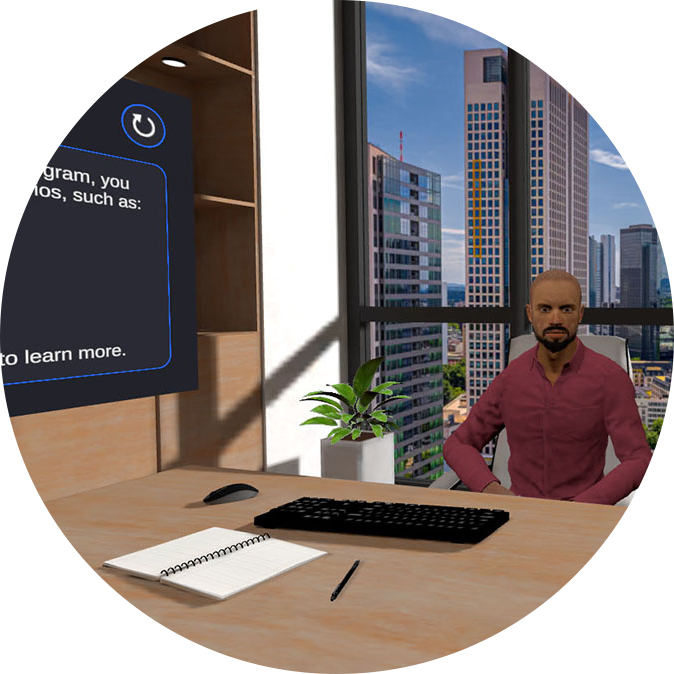
Improving soft skills is easier when training involves real interaction and measurable feedback. One proven solution is VirtualSpeech, an AI-powered training platform used by over 550,000 learners across 130+ countries. Users develop workplace skills such as public speaking, leadership, sales, and interviews through more than 35 AI-driven roleplays and 55 immersive exercises. Training sessions simulate real environments, including presentations in front of virtual audiences and difficult conversations in professional settings.
Unlike passive learning, VirtualSpeech uses generative AI to provide instant feedback after each session. You can track your eye contact, pacing, clarity, and other metrics, allowing targeted improvement. The system also includes e-learning modules that combine with practice sessions, making the experience interactive and structured.
Access is available through browser-based tools or VR headsets like Meta Quest and Pico Neo. Exercises adapt to your level and goals, making the training both flexible and personal. Skills improve up to four times faster compared to traditional methods, with most users reporting a clear boost in confidence and performance.
Benefits of Virtual Reality in Education You Can’t Ignore
Using virtual reality in education offers direct and measurable advantages. Students participate more, stay focused longer, and remember more of what they learn. Instead of just reading or watching, they actively complete tasks. Motivation increases because learning feels more like doing something real, not just studying theory. VR also allows learners to make mistakes and try again without risk, which helps them improve faster. Remote learners or those with special needs gain more control over their environment and pace.
Boosted Engagement, Motivation, and Knowledge Retention
Students often lose focus during traditional lessons, especially with passive methods like lectures or slide presentations. VR changes that by placing learners inside active scenarios where they must solve problems or complete tasks. The sense of presence increases emotional involvement, which leads to better memory retention. In simulations, users receive immediate feedback. They see the results of their actions and adjust on the spot instead of waiting for a test or teacher response.
Gamified elements, such as challenges, progress bars, or badges, further increase motivation. When learners feel in control and receive regular feedback, they stay more committed. Interactive sessions also create stronger links between content and experience, helping the brain store and retrieve information more effectively. Instead of memorizing, students practice, which builds long-term understanding.
Many institutions report higher attendance and participation when VR is included in the curriculum. Students look forward to lessons because they get to do something, not just listen.
Safe Failure: Learning Through Trial Without Real-World Consequences
Making mistakes is part of learning, but in many fields — like medicine, aviation, or chemistry — errors can be costly or dangerous. VR provides a way to practice those skills safely. Trainees can fail, review what went wrong, and try again without risk to themselves, others, or expensive equipment. That cycle of trial, feedback, and repetition improves confidence and accuracy.
In a virtual lab or operating room, learners experience realistic pressure without the actual consequences. Timing, coordination, and decision-making improve through regular practice in repeatable settings. Unlike paper tests or basic quizzes, simulations involve real-time responses and active problem-solving. Each decision affects the outcome, which makes the experience more valuable.
Training programs in healthcare, the military, and manufacturing already rely on this model. Instead of waiting for real-world practice, students build their skills earlier and reach a higher level of readiness before entering the field.
Increased Accessibility for Remote and Special Needs Learners
Not all students can attend physical classes or keep up with standard formats. VR helps close that gap by offering flexible, customizable learning environments. Remote learners can join simulations from anywhere, using only a headset or browser. Special needs students often benefit from the ability to control noise levels, adjust the pace, or use motion controls instead of writing or typing.
Visual learners see concepts in 3D, auditory learners hear instructions and feedback, and kinesthetic learners move and interact with the environment. That variety helps more students find what works for them. For those with sensory sensitivities or mobility issues, VR lessons can be tailored to reduce stress and remove physical barriers.
Some VR platforms include built-in accessibility features like voice commands, subtitles, or simplified environments. That allows more students to learn independently without relying on constant support. Instead of designing one course for everyone, educators can now offer several paths within the same system.
Connect with our experts and discuss your next virtual reality project.
Disadvantages of Virtual Reality in Education
Virtual reality offers useful tools for education, but it also introduces real limitations. Some schools struggle with the cost of devices and software, while others lack the technical support to use them effectively. Students and teachers need time to learn how to use the equipment properly. Extended use can also cause physical strain or discomfort. VR may reduce social interaction if overused, and ethical concerns arise around data privacy and emotional safety.
1. Technological Barriers and Learning Curves
Not every student or teacher has access to the devices needed for VR. Hardware costs, software licensing, and the need for regular updates can create obstacles. Even when schools or training centers invest in the technology, they may not have the IT staff or infrastructure to support it. Connectivity issues, compatibility problems, or outdated systems can slow down or interrupt lessons.
Learning how to use VR tools takes time. Some students may need guidance to feel comfortable in a virtual space, especially if they haven’t used similar tools before. Teachers also need training to integrate VR into their lessons properly. Without support and clear instructions, the technology can become more of a distraction than a benefit.
To ensure that VR works as intended, you need strong technical systems and training programs in place. Otherwise, students will spend more time troubleshooting than learning.
2. Isolation and Reduced Human Interaction
Spending too much time in virtual environments may limit opportunities for social learning. Students who study mainly in VR may miss out on group discussions, informal collaboration, and face-to-face communication. These interactions build teamwork and emotional intelligence, skills that are hard to replicate in a simulation.
In a physical classroom, learners read body language, share spontaneous ideas, and respond to real-time group dynamics. Virtual settings often lack that level of nuance. Some platforms offer voice chat or avatars, but those can feel less personal and may not fully support deeper communication.
When VR is used without balance, it can reduce the personal contact that helps students grow socially and emotionally. You can avoid this by combining VR with group work, live classes, and real-time feedback from instructors.
3. Health and Ethical Concerns
Prolonged VR use can lead to physical discomfort. Headaches, eye strain, nausea, and dizziness affect some users, especially when sessions last longer than recommended. Young children or students with sensory sensitivities may find headsets overwhelming or uncomfortable.
Beyond physical effects, ethical questions also arise. Some platforms collect user data, including movement patterns, voice input, and facial expressions. Without strong privacy rules, that data may be shared or misused. Students also experience emotional stress in some simulations, especially those involving emergency response, trauma, or failure. If not monitored closely, those effects can harm rather than help.
Accessibility is another ethical issue. Not all students can afford or physically use VR equipment, which could widen educational gaps if the technology becomes a core part of the curriculum. Before using VR, it’s important to check for safety guidelines, age recommendations, and clear privacy policies. Training and support are needed not just for using the tools but for using them responsibly.
VR Educational Games — Where Learning Meets Engagement
Virtual reality educational games combine interactive gameplay with immersive experiences, making learning effective and enjoyable. Such games promote active participation and enhance knowledge retention by placing learners in engaging virtual environments.
Game-Based Learning Mechanics in Virtual Worlds
Incorporating game-based learning mechanics into VR environments transforms traditional education into an interactive adventure. Elements such as challenges, rewards, and progression systems motivate learners to engage deeply with the content. For example, VR games often include puzzles that require critical thinking and problem-solving, fostering cognitive development.
Additionally, immediate feedback within these virtual settings helps learners understand their mistakes and adjust their strategies in real-time, reinforcing learning outcomes. The immersive nature of VR ensures that learners are not merely passive recipients of information but active participants in their educational journey.
Examples of VR Educational Games That Work
Several VR educational games have successfully combined learning objectives with engaging gameplay:
Hopster’s Alphabet Hotel. Designed for toddlers, this interactive game introduces children to the letters and sounds of the English alphabet. Featuring colorful animations and simple interfaces, it makes learning the ABCs a fun and straightforward experience. Children explore different rooms within a virtual hotel, each dedicated to a specific letter, enhancing their phonics skills through engaging mini-games.
Math World VR. This game offers a series of mini-games aimed at improving quick math skills. Players engage in activities like basketball and darts, where they solve arithmetic problems to progress, effectively combining physical activity with mental exercises.
Reading World VR. Focused on enhancing literacy skills, this game provides interactive experiences that cover various aspects of reading, including comprehension and spelling, catering to learners from 5th to 9th grade.
These examples demonstrate the potential of VR educational games to create immersive and effective learning experiences across various subjects and age groups.
The Cost of Virtual Reality in Education — Investment or Expense?
Before adding VR to any education program, it’s important to look closely at what it costs and what it returns. Some view it as an expensive tool, while others see it as a long-term investment that pays off through better outcomes. The truth depends on how it's used and supported. VR requires more than just buying headsets — schools must also plan for updates, training, and content. Knowing where the main costs are helps you plan smarter and avoid waste.
Upfront Costs: Hardware, Software, and Setup
VR programs in education require several startup expenses that must be planned carefully.
- Headsets and controllers. Devices like the Meta Quest 2 or Pico Neo 3 range from $300 to $900 per unit, depending on features and quality.
- Computers or mobile devices. Some VR systems need high-spec PCs or mobile tablets to run properly.
- VR-ready classroom space. Open, safe areas are required for movement-based simulations, often needing reconfiguration.
- Licensing fees. Educational platforms may charge monthly or yearly access fees for each student or teacher.
- Staff training. Teachers and support staff must learn how to use and manage the VR tools.
- Installation and setup. Network upgrades, device management systems, and platform integration can take time and money.
Each of these areas contributes to the total initial cost. Planning ahead helps avoid overspending or technical setbacks.
Ongoing Maintenance and Content Development
Keeping a VR system running well requires consistent attention. Hardware must be cleaned, stored, and checked for damage regularly. Schools also need to budget for replacements or upgrades, especially as newer models enter the market every few years. Software updates often include important improvements or security patches, so IT teams must stay informed and apply them correctly. Platforms may also change pricing structures or shift to subscription-only models, increasing annual costs over time.
Custom content is another consideration. While many apps offer general learning modules, building lessons tailored to your curriculum often requires in-house staff or external developers. That can become expensive if frequent updates are needed. Without regular care, VR tools can quickly lose value or go unused. Institutions that invest in clear maintenance plans and content strategies are more likely to see ongoing benefits.
ROI: When Does It Pay Off?
Return on investment (ROI) depends on the purpose and scale of the program. Schools that use VR for technical skills or medical training may see faster payback since simulations reduce the need for costly labs or equipment. Students learn faster, practice more, and perform better on exams, all of which can improve academic outcomes. Cost savings also come from fewer physical materials, less travel for fieldwork, and lower risk in high-stakes training. For example, a single VR welding module can replace dozens of metal pieces and save hours of workshop time.
Time is another factor. If the system runs well and gets used often, the cost per session drops sharply within the first year. However, ROI can be slow or never achieved if the tools are rarely used or poorly managed. Tracking usage, feedback, and skill improvements help measure success. Schools that align VR with learning goals from the start are more likely to get strong returns.
The Future of Virtual Reality in Education: What’s Next?
The adoption of virtual reality in education continues to grow, but the next phase will focus less on novelty and more on integration, scale, and personalization. Future systems will likely be more compact, affordable, and easier to use, which will help schools bring VR into everyday teaching, not just special projects or labs. More platforms are already being designed to run on standalone headsets or even directly in browsers, reducing the need for complex setups.
AI will play a more significant role. Personalized learning experiences will adjust in real time based on how students interact with the material. Instead of one-size-fits-all modules, learners will receive scenarios that adapt to their strengths and weaknesses. Progress data will feed into performance dashboards, giving instructors a clear view of who needs support and when.
Cross-school collaboration could also improve. Shared virtual campuses will allow students in different cities or even countries to take the same class simultaneously. Group projects, language exchanges, or guest lectures may all happen in a single shared simulation. As more educational content becomes modular and open, schools may start building VR curricula the way they now use textbooks or online videos.
Instead of focusing only on technology, the next step will be making it part of everyday education, inasmuch as it's simple to use, focused on skills, and built for learners at every level. Schools that prepare for this shift now will be ready to lead, not follow.
Leverage Virtual Reality in Education with Experts at Program-Ace
Building an effective VR learning environment requires more than just hardware and software. It takes a clear strategy, tested tools, and the right development partner. Program-Ace supports educational institutions with end-to-end services, helping you implement VR that aligns with real learning goals.
As an innovative solutions integrator, Program-Ace creates custom VR content for various subjects, age groups, and skill levels. Whether you want to build interactive training modules, virtual classrooms, or gamified lessons, the team handles design and technical execution using industry-standard engines like Unity and Unreal.
You’ll benefit from ready-to-use frameworks, deep technical support, and an experienced team that understands the demands of education. No guesswork, no generic solutions. Just practical tools built for performance and ease of use. If you are ready to add VR to your education strategy or scale up your current efforts, contact us today to get started with a team that knows what works.
